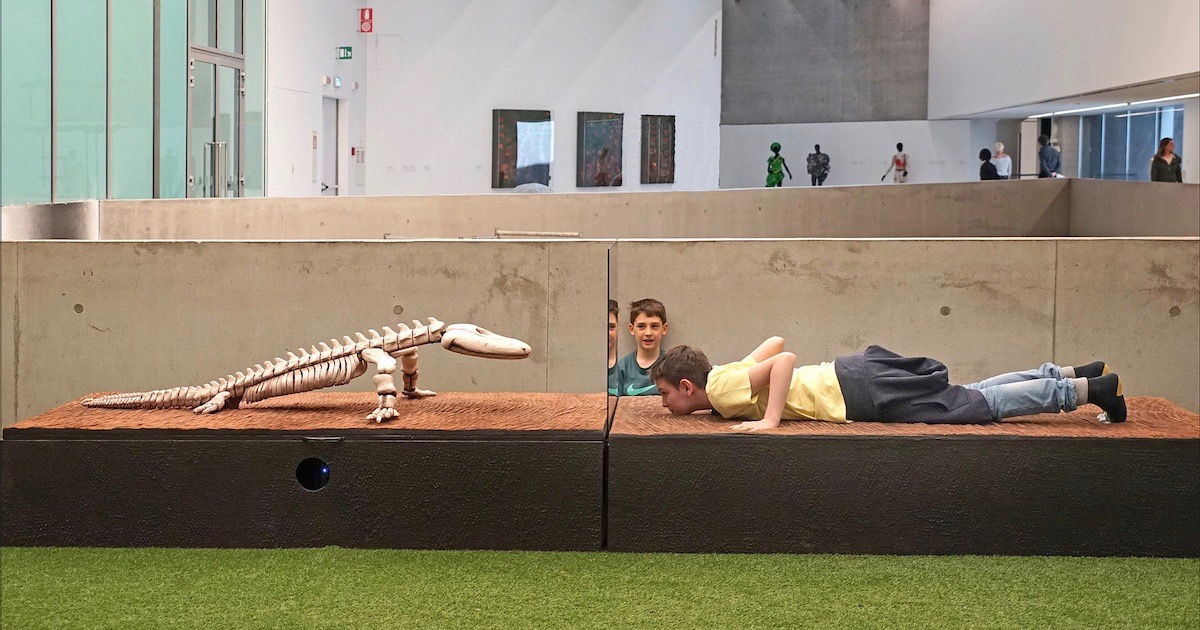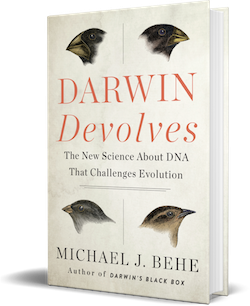 Evolution
Evolution
For Dreams of Darwinian Evolution, First Rule of Adaptive Evolution Is an Insuperable Problem


This is the second in a series of posts responding to the extended critique of Darwin Devolves by Richard Lenski at his blog, Telliamed Revisited. Professor Lenski is perhaps the most qualified scientist in the world to analyze the arguments of my book. He is the Hannah Distinguished Professor of Microbial Ecology at Michigan State University, a MacArthur (“Genius Award”) Fellow, and a member of the National Academy of Sciences. With hundreds of publications, he also has a strong interest in the history and philosophy of science. His own laboratory evolution work is a central focus of the book. I am very grateful to Professor Lenski for taking time to assess Darwin Devolves. His comments will allow interested readers to quickly gauge the relative strength of arguments against the book’s thesis.
In my first post I responded (out of order) to Professor Lenski’s second post, which discussed the polar bear genome. I showed that, regarding my argument that the polar bear’s more efficient lipid metabolism (compared to the brown bear) arose by degradative mutations, his skepticism was unfounded. Briefly, the APOB gene of polar bears is mutated with changes that were predicted by computer methods to be damaging. A 1995 study showed that a mouse model that had one copy of the APOB gene knocked out actually had lower plasma cholesterol levels and increased resistance to hypercholesterolemia from a high fat diet. If the polar bear mutations acted to lower the activity of its own APOB, a result similar to that for the mouse might be expected. Thus there is no good reason to speculate about new functions, as Professor Lenski and others did.
Here I will go back and respond to his first post. For those who don’t have time to read the whole thing, the take-home lessons are these:
- Professor Lenski’s contrasting of the frequency versus importance of evolutionary changes is misconceived and his illustrations are inapt.
- Mindless evolution works only in the short term. That is an insuperable problem for long-term Darwinian progress.
Frequency Versus Importance
The theme of Richard Lenski’s first post, “Does Behe’s ‘First Rule’ Really Show that Evolutionary Biology Has a Big Problem?”, can be summarized by the following excerpts (emphasis in the original):
[W]hen it comes to the power of natural selection, what is most frequent versus most important can be very different things. …
Behe is right that mutations that break or blunt a gene can be adaptive. And he’s right that, when such mutations are adaptive, they are easy to come by. But Behe is wrong when he implies these facts present a problem for evolutionary biology, because his thesis confuses frequencies over the short run with lasting impacts over the long haul of evolution.
As an illustration of the distinction he perceives between frequency and importance, Lenski notes that, while we may feel somewhat sick when infected by a common cold virus, if we get infected by the rarer HIV or Ebola viruses we may well die. The first type of infection is more frequent but the second type is more important. A second example of frequency versus importance that he uses is the stock market. A person who invested an equal amount of money in the stock of 100 separate companies decades ago might get rich even if 80 of the companies eventually went bankrupt — if the other 20 companies did very well. Professor Lenski then writes of Tiktaalik — the famous fossil of a fish with apparent wrist joints — which may be an intermediate on the evolutionary path to all terrestrial vertebrates. Its occurrence was infrequent but certainly important in the history of life.
The problem, of course, is that none of his illustrations is relevant to the matter at hand. At the risk of being insufferably didactic, let me spell it out. The fact that there are various types of viruses that infect humans with varying frequencies and cause illnesses of varying severity says absolutely nothing about the evolution by Darwinian processes of a virus, let alone, say, of an eye or cellular machinery. Neither does the strategy that a person might use for placing bets on the stock market say anything pertinent. And the fact that widely different terrestrial vertebrates descended from an aquatic vertebrate does not even attempt to address the riddle of what drove that descent. It flagrantly begs the question of whether mindless processes are adequate for the task or whether intelligence was necessary, as I argue at book-length in Darwin Devolves. Worst of all, it doesn’t even mention — let alone discuss in detail — the crucial, foundational, molecular level of evolution, which, ironically or not, is Lenski’s own area of great expertise. In short, Professor Lenski — the most qualified scientist in the world to address it — doesn’t even engage the question.
Death by a Thousand Cuts

Not only are Lenski’s illustrations inapt, but the larger point he seemingly wants to make is simply wrong. Frequency itself can magnify the importance of an event, both inside and outside of an evolutionary context. There’s no necessary distinction between the two. When it is multiplied by the number of opportunities to happen, the cumulative importance of an event can be greatly increased. For example, if a person’s chance of dying from each instance of the flu is 5 percent and he is expected to contract the flu ten times in his lifetime, then he should be more worried about that than about contracting Ebola, especially if he lives in a non-infected region. What’s more, multiple separate frequent conditions can interact to yield a much increased, synergistic effect. If both your car’s brakes and tires are worn, the windshield wipers don’t work, and the gas tank has a leak, then you have a much greater risk of a serious accident than with any of the conditions alone.
In the context of evolution, the impact of frequency is much more pronounced — due to natural selection itself. That’s because selection will quickly spread any beneficial mutation, even if the mutation degrades an organism’s genetic patrimony. (After all, as Richard Dawkins and others have emphasized, natural selection is blind.) Thus it will grab on to any mutation that helps at the moment, without regard to the long-term fate of the species, and comparatively quickly increase the numbers of that mutation over the generations until it is fixed in the population (that is, until all members of a species have it). When that happens, the original unmutated version of the gene is gone. Thus any further potentially beneficial changes to come along must work with a degraded foundation. (A real life example is noted by physicians who work on malaria and the many baleful effects of the helpful degradative mutations that were spread in human populations: “This burden is composed not only of the direct effects of malaria but also of the great legacy of debilitating, and sometimes lethal, inherited diseases that have been selected under its impact in the past.”)
No Such Thing as “Importance”
Lenski is comparing reality to wishful thinking. He is contrasting a real process, mutation, with an imaginary attribute, importance. Although frequency is built right into the fundamental equations of molecular evolution as the mutation rate, there is no such thing in those equations — or in all of the Darwinian conception of evolution — as “importance.”
To see that’s the case, consider the basic equation for the expected waiting time to the first appearance of a mutation that will spread in a small population: t = 1 /(2Nvs). The symbol v in the equation is the mutation rate, that is, the frequency at which mutations arise. Other symbols in the equation are: t, the waiting time; N, the population size; and s, the selection coefficient.
There is no term for “importance.” Even the selection coefficient, s, doesn’t measure “importance” in the sense that Professor Lenski uses it. That variable only measures relative survival of offspring, not whether a change is degradative or constructive, good for future development, neutral to it, or a roadblock. As I strongly emphasize in Chapter 8 of Darwin Devolves, beyond the immediate, very next mutational step, Darwin’s mechanism is utterly blind to a species’ survival, let alone to its putative future improvement. In Darwinian evolutionary scenarios the only factor leading to new sophisticated traits is the imagination of the storyteller. It surely isn’t anything to be found in the mathematics of molecular evolution.
The Huge Degradative Advantage
As I initially discussed in a book chapter and as I emphasize in Darwin Devolves, beneficial degradative mutations have a very strong, natural, built-in advantage over beneficial constructive ones, exactly because of their frequency of occurrence. Let me explain briefly here. Consider two genes, either of which when mutated would be beneficial for an organism to meet some particular selective challenge. The first gene (call it A) would be helpful if it mutated (call the mutated protein A*) at a particular residue of the protein it coded for to give a new constructive feature (perhaps a helpful new binding site). The second gene (call it B) would be helpful if it mutated (to B*) so that its activity were substantially degraded or eliminated entirely. Yet there are orders of magnitude — a hundred to a thousand — more ways to degrade B than to improve A. That means that if neither mutation were originally present in the population of a species, B* would be expected to appear in only a hundredth to a thousandth of the time needed for A* to show up. For example, if in this situation the time expected for a constructive mutation to arrive were a hundred thousand years, a degradative mutation would arrive in only one hundred to one thousand years. The result is that B* would have 99,ooo to 99,900 years to spread through the population to fixation before A* even showed up. If both A* and B* relieve the same selective pressure, then when A* eventually did show up there would be no more pressure to relieve, since B* had done so long before. Thus B* has a built in advantage simply because it is degradative — because its mutation rate is much higher.
If a population is large enough to be expected to already contain some copies of A* and B*, then, simply because of the many more ways to break B to produce B*, there would be expected to be a hundred to a thousand times the number of the broken gene in the population compared to A*. That means it would have a hundred to a thousand times the chance of fixing before A*. Looking at it from a different angle, the selection coefficient for B* could be a hundred to a thousand times less that for A* and still have an equal chance to fix in the population first — to fix a degraded gene.
Exponentially Worse
The situation grows exponentially worse if even just two independent changes are needed for what I call in the book a mini-irreducibly complex (mIC) feature, such as a disulfide bond. Here’s what I wrote in Chapter 9, “The Revenge of the Principle of Comparative Difficulty”:
When responding to David Snoke and myself Michael Lynch wrote that, using the assumptions of his optimistic model, “adaptive multiresidue functions can evolve on time scales of a million years (or much less).” Okay, much less — let’s say a hundred thousand years. But, as Richard Lenski’s experimental work (described in Chapter 7) shows so clearly, beneficial-damaging mutations evolve on a time scale of weeks. That’s at least a million times faster than the simplest mIC features evolving by the fastest route imagined. To put that in perspective, damaging mutations are like packages delivered cross-country by FedEx; mutations to construct mIC features are like packages delivered by turtles.
In the real world, any possibly-beneficial, degradative mutations will arrive rapidly, in force, to alleviate any selective pressure on an organism — æons before the first multi-residue feature even appears on the scene. (Figure 9-5) The result is that every degradative change and every damaging single-step mutation would be tested multiple times as a solution, or as part of a solution, to whatever selective pressure a species was facing, and, if helpful, would spread to fixation well before a beneficial multi-residue feature even showed up. Where Darwinian processes dominate, the biological landscape would be expected to be littered with broken-but-helpful genes, damaged-yet-beneficial systems, degraded-organisms-on-crutches, ages before any fancy machinery was even available. That’s exactly what we saw in Chapter 7 with laboratory E. coli, natural Yersinia pestis, wild polar bears, tame dog breeds and all other organisms so far examined.
Random mutation and natural selection — Darwin’s mechanism — ensures that any and all quick-and-dirty degradative fixes (I know, let’s call it “tinkering”) will have a much greater number of chances to take over a population ahead of simple constructive solutions, and an astronomically greater number of chances than even the most modestly cooperative solution. That will overwhelm any significant mindless constructive evolution.
A Brief Point
One final point. In his second post (on the polar bear) Lenski writes concerning targets of degradative evolution: “[T]he function has to be one that is not — or rather, no longer — useful to the organism. For example, eyes are no longer useful to an organism whose ancestors lived above ground, but which itself now lives in perpetual darkness in a cave.” That’s not the case. For example, the CCR5 gene codes for a protein involved in the immune system. HIV uses the protein as an attachment site to allow it to enter cells. Some populations of people are immune to HIV because the gene for the CCR5 protein has been broken. The working protein was useful, but apparently not as useful as immunity to HIV (or an historically related virus). So rather than Lenski’s take, the correct general principle is summarized by The First Rule of Adaptive Evolution: Break or blunt any functional coded element whose loss would yield a net fitness gain. There only has to be a net benefit to a species to throw away a function. That bodes quite poorly for constructive Darwinian evolution.
Image: Boy with interactive sculpture of Tiktaalik, by Piero Gilardi, Rome; photo by Jean-Pierre Dalbéra via Flickr (cropped).
